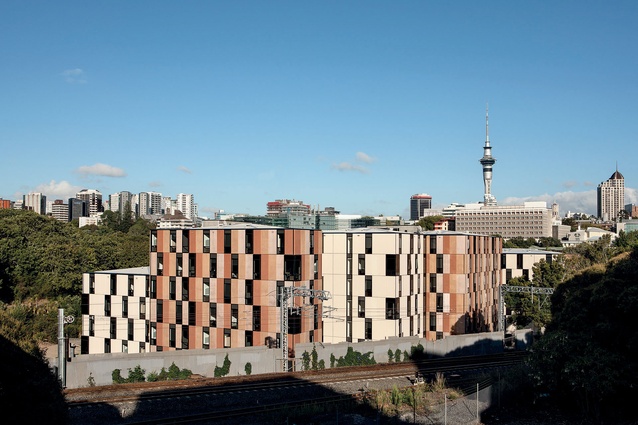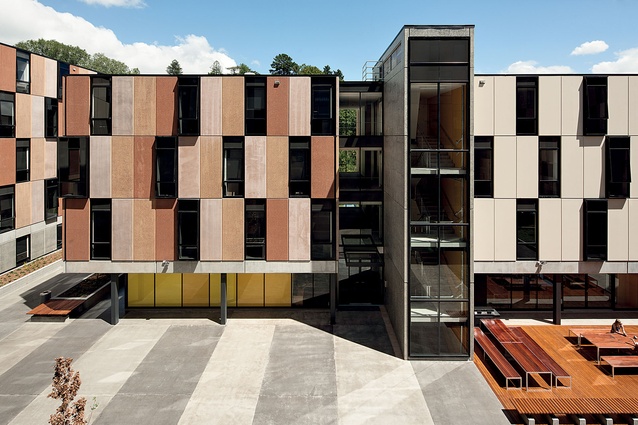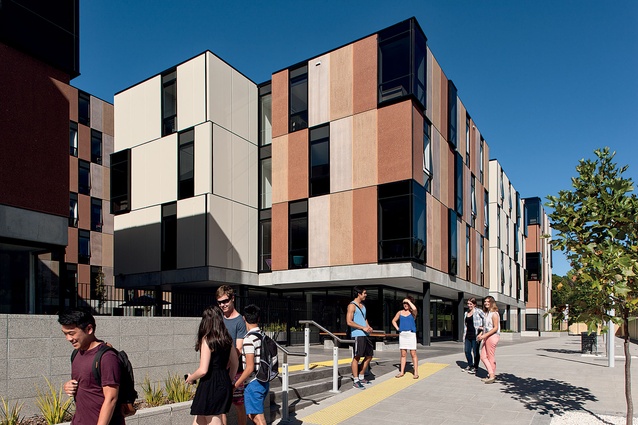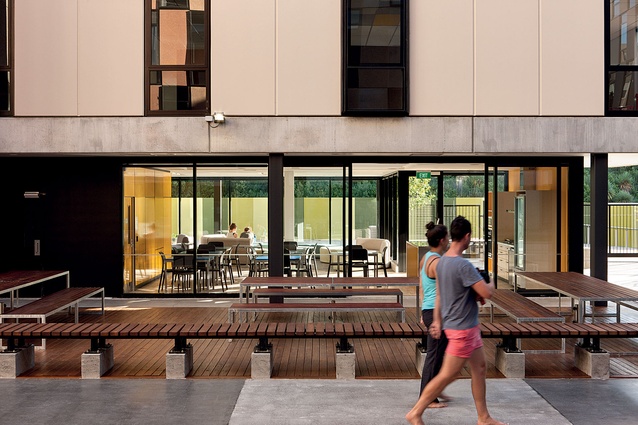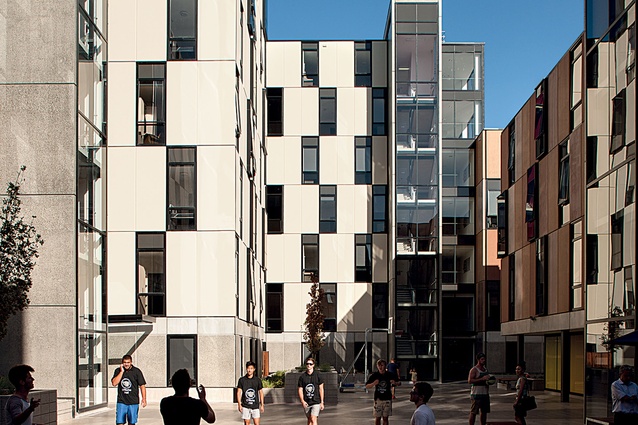Carlaw Park Student Village
Carlaw Park has become associated only recently with comfy and convenient multi-unit residential property. The park was named after James Carlaw, the clever gent who secured the land for Auckland Rugby League in 1920, and the building that traditionally stood on the site was an old wooden spectator stand with a corrugated-iron roof, built in 1916. Creaky and leaky, it was said to be so close to the ground that fans could hear the wind being crushed from the ribcages of tackled rugby league players. In 1959, compelling messages of salvation of a more spiritual kind were preached there by American evangelist Billy Graham to crowds totalling 160,000. In an ironic reversal of his Christian crusading, Santana and Black Sabbath concerts rocked the rafters in the 1970s. Even the Eagles squeezed in a visit before their breakup in 1980.
Now, mirage-like, new and more sedate developments have arisen on the land. A 40-roomed hotel, a 600-space car park and assorted eateries have sprung up, seemingly overnight. Centre stage is Carlaw Park Student Village, a reinvention of the student hostel building type, designed for The University of Auckland by Shannon Joe of Warren and Mahoney, with Paul Morrison as project architect. Less circumscribed by site than was the skinny verticality of their Whittaker Place development, this is the first chapter of a more discursive story. Like G.E. Donnithorne’s Bishop Julius Hall, built in Riccarton for Anglican students at the University of Canterbury in 1975, Carlaw Park stage one comprises a series of low-rise, glazed, concrete-and-steel blocks arranged around an inner courtyard. Basement parking is naturally lit and easily accessed from the street, but also secure and cunningly hidden from view by a line of obligingly leafy trees. Rather than a traditional hall of residence, this 21st-century manifestation of the building type fosters self-sufficiency in its residents, who are all students in the second years of their degrees or older. Configured as self-catering two, three and four-bedroomed units, it can accommodate 668, and was fully rented at $235 a room per week (including a free gym membership) when declared open in February 2014. It currently reigns supreme as the most desirable of The University of Auckland’s student accommodation, with the inaugural intake entitled to bragging rights.
With the university year beginning in autumn and concluding in spring, providing a haven for the hordes in inclement weather was paramount. Instead of high-maintenance lawn, the inner courtyard is paved with concrete, furnished with the obligatory basketball hoop and gas barbecue, and planted with enough trees and shrubs to rescue it from prison exercise-yard comparisons. Sliding glass doors, on the northern side of the communal lounge, open directly onto this shared outdoor area to allow judicious basking in suitable weather.
Within the complex, plenty of north-facing, floor-to-ceiling windows capture the sun and the apartments can be kept perennially toasty with heat pumps to drive out damp and keep keyboard-tapping fingers warm and limber. Spacious hallways, connecting the apartments on each floor, are flooded with natural light, creating a relaxed atmosphere in which to pause and korero. A demonstration kitchen for MasterChef wannabes and networked joint-study spaces in each block provide the extroverts with other opportunities for social interaction. A billiards table, in a fully glazed south-eastern corner of the main building, offers a blokey distraction while waiting for the sheets to spin dry in the adjacent turbo-charged egg-yolk-yellow laundry.
This emphatically cosy interior experience is complemented by a lively external façade, which breaks up the form by balancing solid walls with full-height glazing. Rejecting the idea of architecture as spectacle or aestheticised object, the buildings congregate quietly, indicating that they will endure. Warren and Mahoney has built its reputation on fair-faced concrete, eschewing the finite appeal of fashionable finishes which romance the technological present. Rather than shiny and high-tech, Carlaw Park Student Village looks like it belongs here, plumbed in to both culture and nature. From a distance, the alternation of dark-tinted windows with lighter concrete screens, textured with aggregate and coloured with cream and terracotta hues, appears like tukutuku weaving on the interior of a wharenui. The warm, orange tones complement the chlorophyll greens of the nearby Domain.
Neatly seamed into stacked bands up between four and seven storeys, each block features a completely glazed full-height corner window on every second floor. Structured horizontally and vertically into syncopated patterns, these break up the flatness of the façade. From afar, the ebony and ivory patterning of the entry block, reads like chord sequences, announcing the musical harmony of the complex.
The village’s location at the end of Nicholls Lane and bordering the verdant haunches of Auckland Domain means privacy with the bonus of abundant bird-life. From the cycle rack outside to the top of the new concrete ramp leading to the Owen G. Glenn Building
on Grafton Road takes four minutes on my trusty treadlie and about 10 minutes without wheels. The hard landscaping (in which skateboarders will delight) anticipates the arrival of a Parnell Railway Station, proposed for construction directly behind. It adjoins the approach to the motorway and, from upstairs in the northernmost block, there is a fine view of diesel and electric locomotives hauling carriages east up the tracks; yet, compared to those of inner-city living, the rooms are surprisingly quiet. All in all, the domestic experience is delightful and sophisticated without being staid. Adapting from the more sinister turn of the lyrics in the Eagles’ song ‘Hotel California’, you might say that at Carlaw Park you can check out any time you like but you may never want to leave.

